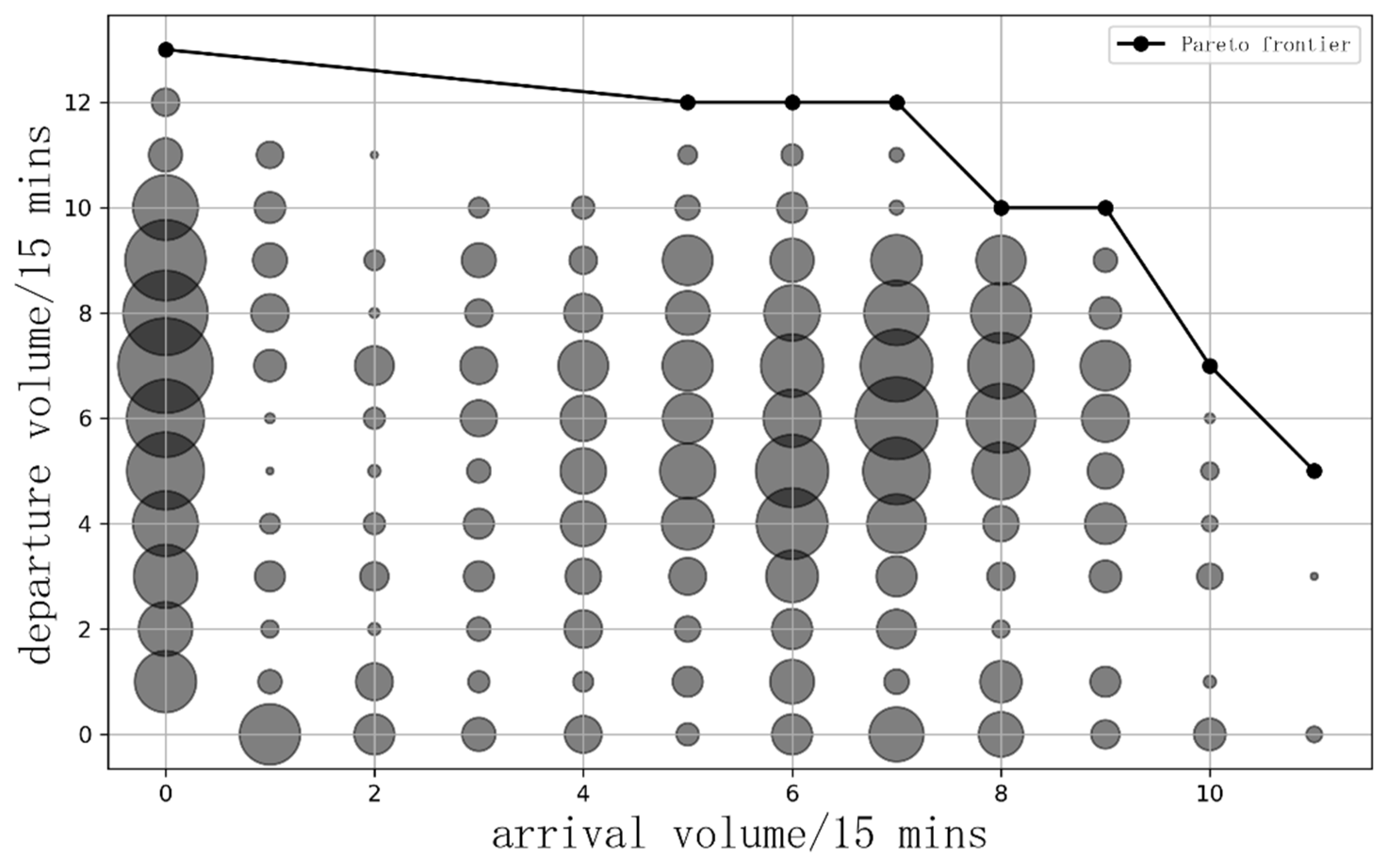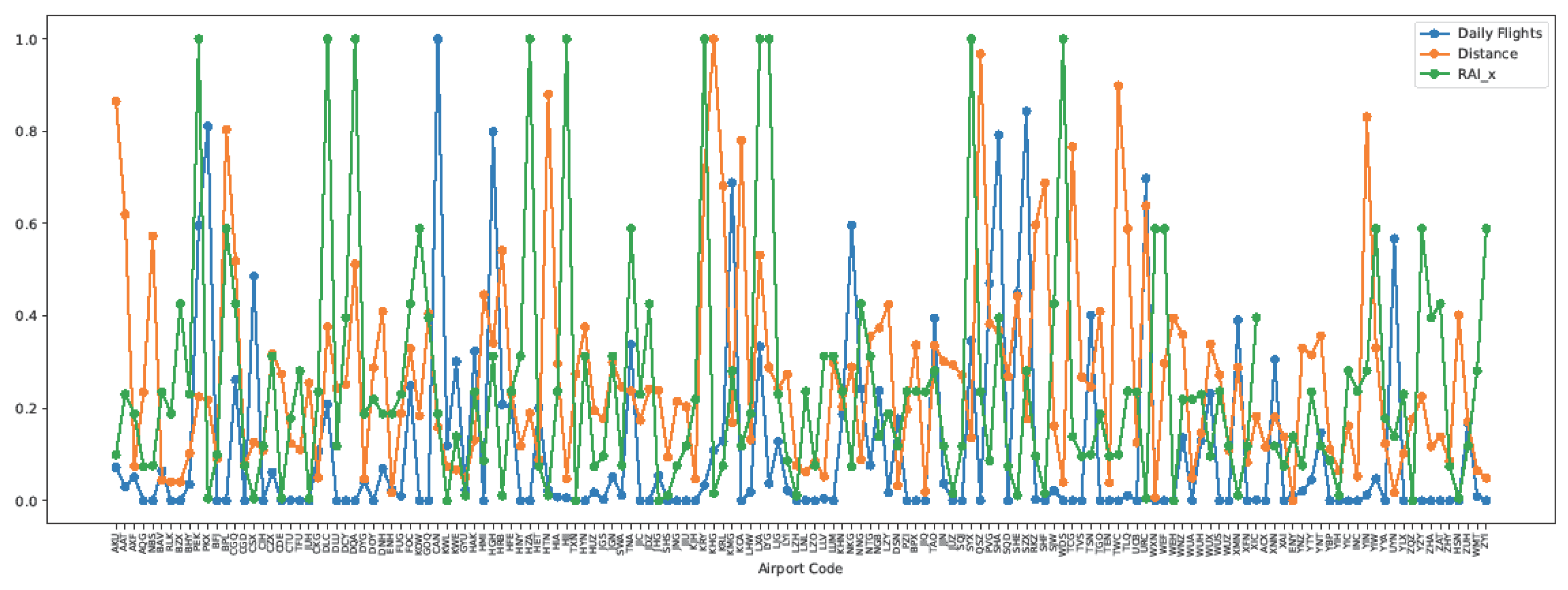Submitted:
10 September 2024
Posted:
10 September 2024
You are already at the latest version
Abstract
Keywords:
1. Introduction
2. Problem Description
- All other operational factors remain normal except for weather changes;
- Pilots fly with the aim of minimizing delays while ensuring safety;
- Flight delays at a certain airport include delays caused during both takeoff and landing at that airport.
3. Methodology
3.1. Resilience of Air Flights
3.1.1. Key Performance Indicators (KPIs)
- Profit loss caused by delays within a time period :where (d_31 (∆t_i)) ̅ is the average delay of each flight in , C_(31/d) is the unit cost of delay per flight.
- Profit loss caused by flight cancellations within a time period :where is the average profit loss caused by a flight cancellation during time , which equals the total value of the flight tickets lost due to the flight cancellation.
3.1.2. Weights of Airport Routes
3.1.3. Resilience of Airport Flight Operation
3.2. The Importance of Weather on Airport Flight Resilience
3.2.1. Establishing the Mapping Relationship between Weather and Airport Resilience
- Input Layer: The input layer consists of nodes corresponding to the number of weather features over the time range to .
- Hidden Layers: The hidden layers employ spline-based activation functions (e.g., B-splines) along the edges. These splines allow the network to capture the nonlinear dependencies between weather conditions and airline operational resilience. Each hidden layer applies a transformation to the inputs from the previous layer.
- Output Layer: The output layer generates the predicted resilience values for the future time steps to . The final layer combines the outputs of the previous layers using summation operations.
3.2.2. Importance Calculation of Input Features
- 4.
- All other operational factors remain normal except for weather changes;
- 5.
- Pilots fly with the aim of minimizing delays while ensuring safety;
- 6.
- Flight delays at a certain airport include delays caused during both takeoff and landing at that airport.
4. Case Study
4.1. Basic Data
- VRB represents variable wind direction, meaning the wind direction changes by more than 180 degrees or the average wind speed is less than 2 meters per second. In this case, the average wind direction value can be interpolated using the stable wind direction values from before and after the observation. Additionally, a binary variable is set: 0 for variable wind direction and 1 for stable wind direction.
- CAVOK indicates good weather and visibility, with visibility greater than 10 kilometers. This is quantified as the minimum value in this case, 10,001 meters.
- For cloud thickness, FEW represents 1/8 to 2/8 cloud cover, SCT represents 3/8 to 4/8 cloud cover, BKN represents 5/8 to 7/8 cloud cover, OVC represents 8/8 cloud cover, SKC indicates clear skies, NSC represents no clouds above 5,000 feet, TCU represents towering cumulus clouds, and CB represents cumulonimbus clouds. For quantification, the maximum value of each cloud type’s thickness is used, and two binary variables are set for towering cumulus and cumulonimbus clouds: 0 represents the absence of these clouds, and 1 represents their presence.
- For the two-hour weather forecast, an ordinal categorical variable is set: TEMPO indicates temporary weather changes, BECMG indicates gradual weather changes, and NOSIG indicates no significant changes in the weather.
4.2. Results and Discussion
4.2.1. Weights of Flight Routes
4.2.2. Values of Route Resilience
4.2.3. Prediction Effectiveness of KAN Model
4.2.4. Analysis of the Importance of Weather Impact
5. Conclusions
Author Contributions
Funding
Institutional Review Board Statement
Informed Consent Statement
Data Availability Statement
Conflicts of Interest
References
- Zhou, Y.M.; Kundu, T.; Qin, W.; Goh, M.; Sheu, J.B. Vulnerability of the worldwide air transportation network to global catastrophes such as COVID-19. Transp. Res. Part E Logist. Transp. Rev. 2021, 154, 102469. [CrossRef] [PubMed]
- Huang, C.N.; Liou, J.J.; Lo, H.W.; Chang, F.J. Building an assessment model for measuring airport resilience. J. Air. Transp. Manag. 2021, 95, 102101. [CrossRef]
- Reitmann, S.; Alam, S.; Schultz, M. Advanced Quantification of Weather Impact on Air Traffic Management. In 13th USA/Europe ATM Research and Development Seminar, 2019.
- Jakšić, Z.; Janić. M. Modeling resilience of the ATC (Air Traffic Control) sectors. J. Air. Transp. Manag. 2020, 89, 101891. [CrossRef]
- Zhou, L.; Chen, Z. Measuring the performance of airport resilience to severe weather events. Transp. Res. Part D Transp. Environ. 2020, 83, 102362. [CrossRef]
- Chen, L.; Miller Hooks, E. Resilience: An Indicator of Recovery Capability in Intermodal Freight Transport. Transport. Sci. 2012, 46, 109-123. [CrossRef]
- Schultz, M.; Lorenz, S.; Schmitz, R; Delgado, L. Weather Impact on Airport Performance. Aerospace 2018, 5, 109. [CrossRef]
- Bruneau, M.; Chang, S.E.; Eguchi, R.T.; Lee, G.C.; O’Rourke, T.D.; Reinhorn, A.M.; Shinozuka, M.; Tierney, K.; Wallace, W.A.; von Winterfeldt, D. A Framework to Quantitatively Assess and Enhance the Seismic Resilience of Communities. Earthq. Spectra. 2003, 19, 733-752. [CrossRef]
- Bao, D.; Zhang, X. Measurement methods and influencing mechanisms for the resilience of large airports under emergency events. Transportmetr. A Transp. Sci. 2018, 14, 855-880. [CrossRef]
- Filippone, E.; Gargiulo, F.; Errico, A.; Di Vito, V.; Pascarella, D. Resilience management problem in ATM systems as a shortest path problem. J. Air. Transp. Manag. 2016, 56, 57-65. [CrossRef]
- ICAO. Doc, 9883—Manual on Global Performance of the Air Navigation System. 2009.
- EUROCONTROL. Performance review report – an assessment of air traffic management in europe during the calendar year 2019. In Technical Report, 2020.
- Schultz, M.; Reitmann, S.; Alam, S. Classification of Weather Impacts on Airport Operations. In 2019 Winter Simulation Conference (WSC), 2019.
- Schultz, M.; Reitmann, S.; Alam, S. Predictive classification and understanding of weather impact on airport performance through machine learning. Transp. Res. Part C Emerg. Technol. 2021, 131, 103119. [CrossRef]
- Borsky, S.; Unterberger, C. Bad weather and flight delays: The impact of sudden and slow onset weather events. Econ.Transp. 2019, 18, 10-26. [CrossRef]
- Wang, Y.J.; Zhan, J.M.; Xu, X.H.; Li, L.S.; Chen, P.; Hansen, M. Measuring the resilience of an airport network. Chinese. J. Aeronaut. 2019, 32, 2694-2705. [CrossRef]
- Bucchignani, E.; Zollo, A.L.; Montesarchio, M. Analysis of Expected Climate Extreme Variability with Regional Climate Simulations over Napoli Capodichino Airport: A Contribution to a Climate Risk Assessment Framework. Earth 2021, 2, 980-996. [CrossRef]
- Vaca-Rubio, C.J.; Blanco, L.; Pereira, R.; Caus, M. Kolmogorov-arnold networks (kans) for time series analysis. ArXiv [Preprint] 2024, arXiv:2405.08790.
- Liu, Z.; Wang, Y.; Vaidya, S.; Ruehle, F.; Halverson, J.; Soljačić, M.; Hou, T.Y.; Tegmark, M. Kan: Kolmogorov-arnold networks. ArXiv [Preprint] 2024. arXiv:2404.19756.
- Krozel, J. Survey of Weather Impact Models used in Air Traffic Management. In 10th AIAA Aviation Technology, Integration, and Operations (ATIO) Conference, 2010.
- Tielrooij, M. Predicting Arrival Time Uncertainty from Actual Flight Information, 2015.
- Janić, M. Analysis and modelling of airport resilience, robustness, and vulnerability: impact of COVID-19 pandemic disease. The Aeronautical Journal 2022, 1-30. [CrossRef]
- Rodríguez-Sanz, Á.; Cano, J.; Rubio Fernández, B. Impact of Weather Conditions on Airport Arrival Delay and Throughput. IOP Conference Series: Materials Science and Engineering 2021, 1024, 012107. [CrossRef]
- Mueller, E.; Chatterji, G. Analysis of Aircraft Arrival and Departure Delay Characteristics. In AIAA’s Aircraft Technology, Integration, and Operations (ATIO) 2002 Technical Forum, 2002.
- Ali, H.; Guleria, Y.; Alam, S.; Schultz, M. A Passenger-Centric Model for Reducing Missed Connections at Low Cost Airports With Gates Reassignment. IEEE Access 2019, 7, 179429-179444. [CrossRef]
- Thompson, K.H.; Tran, H.T. Operational Perspectives Into the Resilience of the U.S. Air Transportation Network Against Intelligent Attacks. IEEE. T. Intell. Transp. 2020, 21, 1503-1513. [CrossRef]
- Chen, Z.; Rose, A. Economic resilience to transportation failure: a computable general equilibrium analysis. Transportation 2018, 45, 1009-1027. [CrossRef]
- Wong, A.; Tan, S.; Chandramouleeswaran, K. R.; Tran, H. T. Data-driven analysis of resilience in airline networks. Transp. Res. Part E Logist. Transp. Rev. 2020, 143, 102068. [CrossRef]
- Köpke, C.; Srivastava, K.; Miller, N.; Branchini, E. Resilience Quantification for Critical Infrastructure: Exemplified for Airport Operations. In Computer Security. ESORICS 2021 International Workshops, 2022.
- Gentry, J.; Duffy, K.; Swedish, W.J. Airport Capacity Profiles. Federal Aviation Administration, 2014.
- Pien, K.C.; Han, K.; Shang, W.L.; Majumdar, A.; Ochieng, W. Robustness analysis of the European air traffic network. Transportmetr. A Transp. Sci. 2015, 11, 772-792. [CrossRef]













| Variables | Time | ||||
|---|---|---|---|---|---|
| 2/23/5:00- 6:00 |
2/23/6:00- 7:00 |
… | 4/15/22:00- 23:00 |
4/15/23:00- 24:00 |
|
| Wind stability | 0 | 1 | … | 1 | 1 |
| Average wind direction (°) | 0 | 210 | … | 360 | 360 |
| Average wind speed (m/s) | 1 | 2 | … | 1 | 1 |
| Visibility (m) | 3000 | 3000 | … | 10001 | 10001 |
| Cloud width 1 | 0 | 0 | … | 0 | 0 |
| Cloud height 1 (feet) | 0 | 0 | … | 0 | 0 |
| Cloud width 2 | 0 | 0 | … | 0 | 0 |
| Cloud height 2 (feet) | 0 | 0 | … | 0 | 0 |
| Cloud width 3 | 0 | 0 | … | 0 | 0 |
| Cloud height 3 (feet) | 0 | 0 | … | 0 | 0 |
| TCU | 0 | 0 | … | 0 | 0 |
| CB | 0 | 0 | … | 0 | 0 |
| Temperature (°) | 10 | 8 | … | 18 | 17 |
| Dew point (°) | 3 | 4 | … | 6 | 9 |
| Corrected sea level pressure (hpa) | 1023 | 1022 | … | 1004 | 1003 |
| Weather forecast | 0 | 0 | … | 0 | 0 |
| Indices | Average daily flight volume | Flight distance | RAI |
|---|---|---|---|
| Average daily flight volume | 1 | -0.16 | 0.94 |
| Flight distance | -0.16 | 1 | -0.18 |
| RAI | 0.94 | -0.18 | 1 |
| Region | Route OD | Route Weight |
| Eastern Coastal Area | Guangzhou Baiyun Airport | 0.9 |
| Eastern Coastal Area | Shanghai Pudong Airport | 0.85 |
| Central Area | Wuhan Tianhe Airport | 0.75 |
| Western Area | Chengdu Shuangliu Airport | 0.7 |
| Western Area | Urumqi Airport | 0.5 |
| Northeastern Area | Harbin Airport | 0.65 |
| Remote Western Area | Lhasa Gonggar Airport | 0.4 |
| Metrics of test set | MSE | RMSE | MAE | MAPE | R2 |
|---|---|---|---|---|---|
| Prediction result | 7424.093 | 86.163 | 60.669 | 0.023 | 99.806% |
Disclaimer/Publisher’s Note: The statements, opinions and data contained in all publications are solely those of the individual author(s) and contributor(s) and not of MDPI and/or the editor(s). MDPI and/or the editor(s) disclaim responsibility for any injury to people or property resulting from any ideas, methods, instructions or products referred to in the content. |
© 2024 by the authors. Licensee MDPI, Basel, Switzerland. This article is an open access article distributed under the terms and conditions of the Creative Commons Attribution (CC BY) license (http://creativecommons.org/licenses/by/4.0/).





